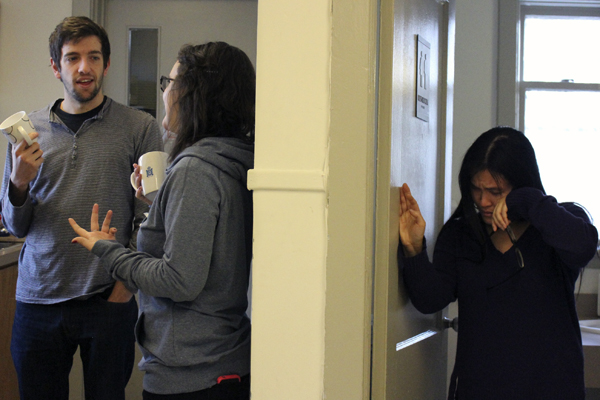Cliques aren’t only an issue throughout high school—they extend to university and into the workplace, too
Photo by Tina Wallace
First-year jitters
Moving away from my small hometown to attend the University of Ottawa was a big step for me. My parents drove three hours and dropped me off at residence, and it was daunting, to say the least. But I was ready to meet new people, study English, and finally get the chance to use my French.
University is an opportunity to start fresh, and I knew that whoever I was in high school wouldn’t necessarily translate into the person I would be in university. High school was over, wasn’t it?
It didn’t quite feel that way when my roommate in residence already had a best friend and didn’t seem to want another one. Even so, I tried to fit in with my other floor mates when they met in the common rooms on the weekends, mostly hanging out and playing drinking games. I know that I don’t have the most outgoing personality, but the group’s dynamic made it clear that I wasn’t really accepted by that crowd.
It didn’t matter that I sat down and joined them—I was still an outsider. I couldn’t even equate the behaviour to bullying because they weren’t saying anything to purposely hurt me. Simply put, they were silently excluding me.
Curtis Larsen, a fourth-year forensic science student at Carleton University witnessed such a phenomenon in his first year in residence as well.
“In my residence, my floor was shaped like an L, and I hardly knew anyone in the other hall; it was like an entirely different floor,” he said. “Everyone was really friendly when I first moved in and groups of friends were formed pretty quickly, but after a while the groups just began to stay the same. Everyone was in their place.”
This is a perfect example of a clique—a group of close-knit people who don’t readily allow others to join them. Cliques are typically abundant in high school, and that’s to be to expected. Most young adult TV shows depict a high school with the designated popular and unpopular groups. My high school was the same, but university is supposed to be a different story, everyone should be on the same playing field.
University of Colorado professor Patricia A. Adler and University of Denver professor Peter Adler published a paper in the Social Psychology Quarterly, studying cliques in-depth. They found that “cliques (are) characterized by frequent group activities designated to foster some individuals’ inclusion while excluding others.”
Over time, groups of people find each other and form cliques. Perhaps the clique members are not aware of their position, but from an outsider’s point of view, it can be quite obvious. Common interest can be a powerful thing; cliques mostly stem from common ground. Even the smallest similarities in people can cause a clique’s formation, like a fresh start in university when friendships have yet to be made.
If I tried to figure out why I felt excluded from the other first-year students back in residence, I would probably drive myself crazy. Was it because Kings wasn’t my favourite drinking game? Maybe it was because I’m from a small town that no one had ever heard of. People decide to stick together for different reasons, and sometimes there’s nothing you can do about it.
The Adlers explain the clique’s process and how its members are drawn to the idea of comfort and stability within a supposed welcoming group. They write that cliques generally form around one or two leaders, and those people specifically are why cliques are so toxic.
“Cliques are circles of power wherein leaders attain and wield influence over their followers by cyclically building them up and cutting them down, first drawing them into the elite inner circle and allowing them to bask in the glow of popularity and acceptance, and then reducing them to positions of dependence and subjugation by turning the group against them,” they wrote.
Dorm rooms and classes aren’t the only places people begin to form cliques. The leaders the Adlers refer to can be found on sports teams as well. Though teams usually play for the same reasons—mostly to have fun and to succeed—competition can get in the way. U of O master’s student Anna MacDonald enjoyed playing for a house league soccer team every summer for years until a particular player ruined the sport for her.
“There were five girls who decided to join our team who were already clearly in a competitive league,” she said. “One girl appointed herself captain, coach, and queen bitch. She was so aggressive that the other players followed suit and evolved into her personality, they were either scared of this girl or just didn’t know what to do in the situation.”
MacDonald also mentioned that this player was 28 years old at the time, which underscores that cliques are not always limited to high school students.
Working girl
Many students work while they attend university, and the workplace has the potential to have cliques as well, even amongst adults who should know better.
When I secured my first job after graduating from the U of O, I was ecstatic. After months of handing out résumés, attending interviews, and making constant phone calls, I could finally say I had a job. As the new girl, I knew it would be an adjustment, but the work environment was friendly enough.
It quickly became clear to me and the other new employees that certain groups existed in the office. The lunchroom was like a high school cafeteria, and you were either invited to the “cool table” or you weren’t. There were also mandatory employee meetings where neither I nor the other new employees could get a word in because our older colleagues would only acknowledge each other.
It’s normal for employees to have friends at work, but when they create groups unwelcome to others, that’s when problems arise.
Results from a CareerBuilder study published in Forbes Magazine found that 43 per cent of workers say their office is populated by cliques.
I wonder if the other 57 per cent are clique members.
Cliques in the office can easily translate to social gatherings, whether a co-worker invites you to a party or your workplace has a staff get-together. My job had a couple of these, and I went because I not only wanted to get to know the people but I also wanted to show them I could fit in.
The occasion was a simple party at a colleague’s house. When I entered the main room, all I could see were people sitting in groups. The host even had a group of his own and wasn’t interested in making anyone feel comfortable.
I eventually found a group to join, but I soon realized I had become part of the problem. There were others who sat alone and who clearly felt awkward. It seemed like no one wanted to mingle or introduce themselves to others.
The Adlers explain that groupings like these are typical of cliques, as they highlight the included members and therefore make individuals feel more comfortable with their status in the clique.
“Many clique members relish the opportunity to go along with such exclusive activities, welcoming the feelings of privilege, power, and inclusion,” they wrote.
The clique mentality is a tough one to understand. Why does it happen in the first place?
In the Forbes article, Amy Hoover, president of web-based job search resource Talent Zoo, provides an answer.
“People are creatures of habit, and the habits you pick up early in life often carry through to adulthood,” she said. “One of those habits is to group with others who are like-minded or similar to ourselves. It happens at work, at parties, at networking events—any place where there are groups of people.”
It’s interesting that cliques exist in some establishments and not others. I wasn’t used to cliques in the workplace until I graduated and found a job in Ottawa. Before that, every summer I would move back to my hometown—with a population of 2,000—where I worked for a manufacturing company.
The employees in this factory generally have limited education, limited wages, and limited opportunities for better employment in the future. I assumed that because of my educational background I would have been ostracized when I began working for the factory. Instead, I have never encountered a kinder, friendlier, or more welcoming collection of individuals.
The results from the CareerBuilder survey may help to reveal why some workplaces have more cliques than others. The study states that employees who claimed to fit a specific stereotype in high school, like the athlete, cheerleader, geek, class clown, or teacher’s pet, are more likely to be in a clique in their workplace.
The study also mentions that while 27 per cent of people surveyed who considered themselves extroverts are members of an exclusive work social group, only 17 per cent of people who considered themselves introverts participate in workplace cliques.
Maybe my colleagues were introverts, or maybe they didn’t care about stereotypical high school archetypes. Regardless, every worker was equal, everyone had to bear the hard work and extreme heat of each summer together, and I always felt included.
You either fit in or you don’t
Cliques are exclusive, and not everyone gets an invitation. If you don’t, it’s best to find a more accepting group. University students may be unaware that cliques exist, insisting that this type of exclusion only happens in high school or in movies like Mean Girls, but it does.
MacDonald experienced the reality of cliques when she considered joining a club at the university during her undergraduate studies.
“I had heard a lot about this particular club and was genuinely interested in getting involved,” she said. “I had been told time and time again that participating in extra-curricular activities would not only enrich my undergraduate experience but also bolster my résumé. To my surprise, going to the first club meeting was a complete disappointment. I felt like I had regressed back to my junior high days, everyone around me made me feel extremely uncomfortable and treated me like I shouldn’t have been there.”
Of course, it doesn’t happen to everyone. Abraham Alexander, third-year marketing student at Carleton, hasn’t felt rejected from a group since he started university.
“I haven’t really had any issue with that,” he said. “The only cliques that come to mind are fraternities and sororities. Everything else I’ve experienced has been very open and inclusive. I don’t know if I’m an anomaly or not, but that’s what I’ve found.”
Cliques can also be avoided. Houssein Hassan, a third-year accounting student at the U of O, has avoided exclusion by staying with the same group for years, even when he started university.
“I already had most of my friends from high school there, so I kind of had my circle already,” he said.
I didn’t have the privilege that Hassan did, and lots of students don’t. At the U of O, I had to make a new group of friends for myself, but with a little patience, I succeeded.
Let’s get over ourselves
Though there are people I encountered in university who preferred to remain within their cliques, I’m not jealous of them. Cliques may be a source of comfort for some, but they also have the power to alienate the company of potential friends. By accepting others, new relationships can be forged and new memories made.
An article by Tambra Weigman, published in Shepherd University’s publication the Picket, advises clique members to offer invitations to others.
“If people continue to stay in their cliques, they will miss out on so much,” she wrote. “Yes, I understand you may have more in common with certain people, but don’t chain yourself to one idea. Open up and explore the world around you. The most wonderful person you could ever meet may be out there waiting, but most people will never have the chance to meet this person because they refuse to unhinge themselves from their cliques.”
If cliques have the power to influence the behaviours of its members, the possible consequences could be very negative. The Adlers warn that social exclusion could turn into something more serious.
“Clique dynamics of inclusion and exclusion teach young people the fundamental values of conflict and prejudice,” they wrote. “As such, they may form the basis for the societal reproduction of racism, anti-Semitism, sexism, and other forms of bigotry and discrimination.”
Groups of like-minded people don’t have to carry negative connotations if they are welcoming to others. It’s easier to stay within our comfort zones, but if certain people started to accept the idea of meeting new and interesting people, we wouldn’t need cliques to conform to.
Cliques can be encountered anywhere, but they don’t have to define who you are.





